The Impact of Climate Variability on the Blooming of Fraxinus ornus ‘Globosa’ as a Component of Novi Sad’s (Serbia) Green Infrastructure
Abstract
:1. Introduction
2. Materials and Methods
2.1. Study Area
2.2. Acquisition of Data
2.2.1. Climatic Data
2.2.2. Phenological Data
2.2.3. Plant Material
2.3. Processing of Data
3. Results
3.1. Chronology of Climatic Parameters
3.2. Phenology and Flowering Patterns
3.3. Morphological Analysis of Compound Inflorescences of Globe Flowering Ash
4. Discussion
5. Conclusions
Supplementary Materials
Author Contributions
Funding
Institutional Review Board Statement
Informed Consent Statement
Data Availability Statement
Acknowledgments
Conflicts of Interest
References
- Rosenzweig, C.; Solecki, W.; Romero-Lankao, P.; Mehrotra, S.; Dhakal, S.; Bowman, T.; Ibrahim, S. Climate Change and Cities: Second Assessment Report of the Urban Climate Change Research Network; Cambridge University Press: Cambridge, UK, 2018. [Google Scholar]
- Patarkalashvili, T.K. Urban Forests and Green Spaces of Tbilisi and Ecological Problems of the City. Ann. Agrar. Sci. 2017, 15, 187–191. [Google Scholar] [CrossRef]
- Molla, M. The Value of Urban Green Infrastructure and Its Environmental Response in Urban Ecosystem: A Literature Review. Int. J. Environ. Sci. 2015, 4, 89–101. [Google Scholar]
- Mullaney, J.; Lucke, T.; Trueman, S.J. A Review of Benefits and Challenges in Growing Street Trees in Paved Urban Environments. Landsc. Urban Plan. 2015, 134, 157–166. [Google Scholar] [CrossRef]
- Parreño, M.A.; Alaux, C.; Brunet, J.; Buydens, L.; Filipiak, M.; Henry, M.; Keller, A.; Klein, A.; Kuhlmann, M.; Leroy, C.; et al. Critical links between biodiversity and health in wild bee conservation. Trends Ecol. Evol. 2022, 37, 309–321. [Google Scholar] [CrossRef] [PubMed]
- Ballard, W.; Wilson, B.; Udale-Clarke, S.; Illman, H.; Ashley, T.; Kellagher, R. The SuDS Manual; CIRIA C753: London, UK, 2015; p. 968. Available online: https://www.ciria.org/ItemDetail?iProductCode=C753F&Category=FREEPUBS (accessed on 30 March 2024).
- Zhang, S.; Song, H.; Li, X.; Luo, S. Urban Parks Quality Assessment Using Multi-Dimension Indicators in Chengdu, China. Land 2024, 13, 86. [Google Scholar] [CrossRef]
- Primack, R.B.; Higuchi, H.; Miller-Rushing, A.J. The impact of climate change on cherry trees and other species in Japan. Biol. Conserv. 2009, 142, 1943–1949. [Google Scholar] [CrossRef]
- Kunz, A.; Blanke, M. “60Years on”—Effects of ClimaticChange on Tree Phenology—A CaseStudy Using Pome Fruit. Horticulturae 2022, 8, 110. [Google Scholar] [CrossRef]
- Wallander, E. Systematics of Fraxinus (Oleaceae) and Evolution of Dioecy. Plant Syst. Evol. 2008, 273, 25–49. [Google Scholar] [CrossRef]
- Brickell, C.D.; Kelly, A.F.; Schneider, F.; Voss, E.G. International Code of Nomenclature for Cultivated Plants—1980. Regnum Veg. 1980, 104, 32. [Google Scholar]
- Obrknežev, R.; Gačević, R.; Bursać, T.; Grujić, Z.; Jovković, M.; Panjković, A.; Marković, V.; Šešum, M.; Letić, M.; Paunić, M.; et al. Studija Zaštite Životne Sredine Novog Sada; Javno preduzeće “Urbanizam” Zavod za urbanizam: Novi Sad, Serbia, 2009. [Google Scholar]
- Živković, B.; Nejgerbauer, V.; Tanasijević, Đ.; Miljković, N.; Stojković, L.; Drezgić, P. Zemljišta Vojvodine; Institut za Poljoprivredna Istraživanja: Novi Sad, Serbia, 1972. [Google Scholar]
- Tomić, Z. Šumarska Fitocenologija; Šumarski Fakultet Univerziteta u Beogradu: Beograd, Serbia, 2004; pp. 176–182. [Google Scholar]
- WMO. State of the Global Climate 2021: WMO Provisional Report; World Meteorological Organization (WMO): Geneva, Switzerland, 2021; p. 47. Available online: https://library.wmo.int/records/item/56300-state-of-the-global-climate-2021 (accessed on 10 December 2023).
- Republički Hidrometeorološki Zavod Srbije (RHMZ). Available online: https://www.hidmet.gov.rs/ciril/meteorologija/klimatologija_godisnjaci.php (accessed on 10 May 2024).
- Republički Hidrometeorološki Zavod Srbije (RHMZ). Available online: https://www.ogimet.com/synopsc.phtml.en (accessed on 10 May 2024).
- Fries, A.; Rollenbeck, R.; Nauß, T.; Peters, T.; Bendix, J. Near Surface Air Humidity in a Megadiverse Andean Mountain Ecosystem of Southern Ecuador and Its Regionalization. Agric. For. Meteorol. 2012, 152, 17–30. [Google Scholar] [CrossRef]
- Koch, E.; Bruns, E.; Chmielewski, F.M.; Defila, C.; Lipa, W.; Menzel, A. Guidelines for Plant Phenological Observations. Available online: https://www.researchgate.net/publication/266211199 (accessed on 1 January 2010).
- Meier, U. (Ed.) BBCH-Monograph. Growth Stages of Plants. Entwicklungsstadien von Pflanzen. Estadios de las Plantas. Stades de Développement des Plantes; Blackwell Wissenschafts-Verlag: Berlin, Germany, 1997; p. 622. [Google Scholar]
- Buttler, K.P.; Schmid, W. (Eds.) Anleitung für die phänologischen Beobachter des Deutschen Wetterdienstes, 3rd ed.; Deutscher Wetterdienst: Offenbach am Main, Germany, 1991.
- Lalić, B.; Ejcinger, J.; Dalamarta, A.; Orlandini, S.; Firanj Sremac, A.; Paher, B. Meteorologija i klimatologija za agronome; Univerzitet u Novom Sadu-Poljoprivredni fakultet: Novi Sad, Serbia, 2021; p. 219. [Google Scholar]
- WMO. Guidelines for Plant Phenological Observations; WMO/TD No. 1484; 2009; Available online: https://library.wmo.int/records/item/51138-guidelines-for-plant-phenological-observations (accessed on 20 December 2023).
- McMaster, G.S.; Wilhelm, W.W. Growing degree-days: One equation, two interpretations. Agric. For. Meteorol. 1997, 87, 291–300. [Google Scholar] [CrossRef]
- Gilbert, R.O. Statistical Methods for Environmental Pollution Monitoring; Van Nostrand Reinhold: New York, NY, USA, 1987. [Google Scholar]
- RHMZ. Available online: https://www.hidmet.gov.rs/data/klimatologija/ciril/zima.pdf (accessed on 18 June 2024).
- RHMZ. Available online: https://www.hidmet.gov.rs/data/klimatologija/ciril/prolece.pdf (accessed on 18 June 2024).
- RHMZ. Available online: https://www.hidmet.gov.rs/data/klimatologija/ciril/leto.pdf (accessed on 18 June 2024).
- RHMZ. Available online: https://www.hidmet.gov.rs/data/klimatologija/ciril/jesen.pdf (accessed on 18 June 2024).
- IPCC. Climate Change and Land: An IPCC Special Report on Climate Change, Desertification, Land Degradation, Sustainable Land Management, Food Security, and Greenhouse Gas Fluxes in Terrestrial Ecosystems; Shukla, P.R., Skea, J., Calvo Buendia, E., Masson-Delmotte, V., Pörtner, H.-O., Roberts, D.C., Zhai, P., Slade, R., Connors, S., van Diemen, R., et al., Eds.; Cambridge University Press: Cambridge, UK; New York, NY, USA, 2019. [Google Scholar]
- IPCC. Global Warming of 1.5 °C. An IPCC Special Report on the Impacts of Global Warming of 1.5 °C Above Pre-Industrial Levels and Related Global Greenhouse Gas Emission Pathways, in the Context of Strengthening the Global Response to the Threat of Climate Change, Sustainable Development, and Efforts to Eradicate Poverty; Masson-Delmotte, V., Zhai, P., Pörtner, H.-O., Roberts, D., Skea, J., Shukla, P.R., Pirani, A., Moufouma-Okia, W., Péan, C., Pidcock, R., et al., Eds.; Cambridge University Press: Cambridge, UK; New York, NY, USA, 2018. [Google Scholar]
- Vujović, D.; Todorović, N. Urban/Rural Fog Differences in the Belgrade Area, Serbia. Theor. Appl. Climatol. 2019, 131, 889–898. [Google Scholar] [CrossRef]
- Denny, E.; Gerst, K.L.; Miller-Rushing, A.J.; Tierney, G.L.; Crimmins, T.M.; Enquist, C.A.; Guertin, P.; Rosemartin, A.H.; Schwartz, M.D.; Thomas, K.A.; et al. Standardized Phenology Monitoring Methods to Track Plant and Animal Activity for Science and Resource Management Applications. Int. J. Biometeorol. 2014, 58, 591–601. [Google Scholar] [CrossRef] [PubMed]
- Idžojtić, M. Dendrologija—Cvijet, Češer, Plod, Sjeme; Sveučilište u Zagrebu, Šumarski fakultet: Zagreb, Croatia, 2013. [Google Scholar]
- Zuo, J.; Zhao, Z.Y. Green Building Research–Current Status and Future Agenda: A Review. Renew. Sustain. Energy Rev. 2014, 30, 271–281. [Google Scholar] [CrossRef]
- Santamouris, M. Cooling the Cities—A Review of Reflective and Green Roof Mitigation Technologies to Fight Heat Island and Improve Comfort in Urban Environments. Sol. Energy 2014, 103, 682–703. [Google Scholar] [CrossRef]
- Li, X.; Zhou, Y.; Asrar, G.R.; Mao, J.; Li, X.; Li, W. Response of Vegetation Phenology to Urbanization in the Conterminous United States. Glob. Change Biol. 2016, 23, 2818–2830. [Google Scholar] [CrossRef]
- Cosmulescu, S.; Stanciu Buican, A.; Ionescu, M. The Influence of Temperature on Phenology of Ornamental Woody Species in Urban Environment. Sci. Pap. Ser. B Hortic. 2020, 64, 61–67. [Google Scholar]
- Burkle, L.A.; Marlin, J.C.; Knight, T.M. Plant-Pollinator Interactions over 120 Years: Loss of Species, Co-Occurrence, and Function. Science 2013, 339, 1611–1615. [Google Scholar] [CrossRef]
- Qiu, J.; Carpenter, S.R.; Booth, E.G.; Motew, M.; Zipper, S.C.; Kucharik, C.J.; Loheide, S.P., II; Turner, M.G. Understanding Relationships among Ecosystem Services across Spatial Scales and over Time. Environ. Res. Lett. 2018, 13, 054020. [Google Scholar] [CrossRef]
- Li, Q.; Zhu, Y.; Zhu, Z. Calculation and Optimization of the Carbon Sink Benefits of Green Space Plants in Residential Areas: A Case Study of Suojin Village in Nanjing. Sustainability 2023, 15, 607. [Google Scholar] [CrossRef]
- Petrov, D.; Ocokoljić, M.; Galečcić, N.; Skočajić, D.; Simović, I. Adaptability of Prunus cerasifera Ehrh. to Climate Changes in Multifunctional Landscape. Atmosphere 2024, 15, 335. [Google Scholar] [CrossRef]
- Armour, T.; Armour, S.; Hargrave, J.; Revell, T. Cities Alive: Rethinking Green Infrastructure; Arup: London, UK, 2014; Available online: https://www.arup.com/globalassets/downloads/insights/cities-alive-rethinking-green-infrastructure.pdf (accessed on 20 June 2024).
- Rogers, K.; Jaluzot, A.; Neilan, C. Green Benefits in Victoria Business Improvement District: An Analysis of the Benefits of Trees and Other Green Assets in the Victoria Business Improvement District, An i-Tree Eco, CAVAT and G.I. Valuation Study; 2012; Available online: https://www.itreetools.org/documents/356/VictoriaUK_BID_iTree.pdf (accessed on 20 June 2024).
- Wróblewska, K.; Jeong, B.R. Effectiveness of Plants and Green Infrastructure Utilization in Ambient Particulate Matter Removal. Environ. Sci. Eur. 2021, 33, 110. [Google Scholar] [CrossRef] [PubMed]
- Caudullo, G.; de Rigo, D. Fraxinus ornus in Europe: Distribution, Habitat, Usage and Threats. In European Atlas of Forest Tree Species; San-Miguel-Ayanz, J., de Rigo, D., Caudullo, G., Houston Durrant, T., Mauri, A., Eds.; Publ. Off. EU: Luxembourg, 2016; pp. 100–101. [Google Scholar]
- Vujičić, D.; Vasiljević, N.; Radić, B.; Tutundžić, A.; Galečić, N.; Skočajić, D.; Ocokoljić, M. Conceptualisation of the Regulatory Framework of Green Infrastructure for Urban Development: Identifying Barriers and Drivers. Land 2024, 13, 692. [Google Scholar] [CrossRef]
- Giovanetti, M.; Aronne, G. Honey Bee Interest in Flowers with Anemophilous Characteristics: First Notes on Handling Time and Routine on Fraxinus ornus and Castanea sativa. Bull. Insectology 2011, 64, 77–82. [Google Scholar]
- Abbate, L.; Mercati, F.; Di Noto, G.; Heuertz, M.; Carimi, F.; Fatta Del Bosco, S.; Schicchi, R. Genetic Distinctiveness Highlights the Conservation Value of a Sicilian Manna Ash Germplasm Collection Assigned to Fraxinus angustifolia (Oleaceae). Plants 2020, 9, 1035. [Google Scholar] [CrossRef] [PubMed]
- Ocokoljić, M.; Petrov, D.J. Decorative Dendrology [Dekorativna dendrologija]; Univerzitet u Beogradu-Šumarski Fakultet: Belgrade, Serbia, 2022; p. 409. (In Serbian) [Google Scholar]
- Bochenek, G.M.; Eriksen, B. First Come, First Served: Delayed Fertilization Does Not Enhance Pollen Competition in a Wind-Pollinated Tree, Fraxinus excelsior L. (Oleaceae). Int. J. Plant Sci. 2011, 172, 60–69. [Google Scholar] [CrossRef]
- Buican Stanciu, A.; Ionescu, M.; Cosmulescu, S.N. The Influence of Urban Conditions on the Phenology of Some Ornamental Species. Biharean Biol. 2021, 15, 75–79. [Google Scholar]
- Slobodník, B.; Šufliarsky, J.; Slobodníková, L.; Škvarenina, J. Changes in the Course of the Spring Generative Phenological Phases in Manna Ash (Fraxinus ornus L.) in Dependence on the Air Temperature Conditions. In Proceedings of the Mendel and Bioklimatologie, International Conference, Brno, Czech Republic, 3–5 September 2014; pp. 3–5. [Google Scholar]
- Slobodník, B.; Miňová, L.; Rácz, A.; Belčáková, I.; Štefunková, Z. Analysis of Chosen Growth and Reproductive Traits of Manna Ash (Fraxinus ornus) with Regards to Its Expansive Properties. Biosyst. Divers. 2023, 31, 217–221. [Google Scholar] [CrossRef]
- FRAXIGEN. Ash Species in Europe: Biological Characteristics and Practical Guidelines for Sustainable Use; Oxford Forestry Institute, University of Oxford: Oxford, UK, 2005; p. 128. [Google Scholar]
- Dommée, B.; Geslot, A.; Thompson, J.D.; Reille, M.; Denelle, N. Androdioecy in the Entomophilous Tree Fraxinus ornus (Oleaceae). New Phytol. 1999, 143, 419–426. [Google Scholar] [CrossRef]
- Pannell, J.R. What Is Functional Androdioecy? Funct. Ecol. 2002, 16, 858–869. [Google Scholar] [CrossRef]
- Wallander, E. Systematics and Floral Evolution in Fraxinus (Oleaceae). Belg. Dendrol. 2012, 38–58. [Google Scholar]
- Hirons, A.D.; Sjöman, H. Tree Species Selection for Green Infrastructure: A Guide for Specifiers, Issue 1.3; Trees & Design Action Group: Exeter, UK, 2019; Available online: https://www.tdag.org.uk/uploads/4/2/8/0/4280686/tdag_treespeciesguidev1.3.pdf (accessed on 24 June 2024).
- Škvarenina, J.; Kunca, V.; Križová, E.; Tomlain, J. Impact of the climate change on the water balance of altitudinal vegetation zones and changed critical loads in forest ecosystems in Slovakia. For. J. 2006, 52, 49–59. [Google Scholar]
- Machar, I.; Voženílek, V.; Kirchner, K.; Vlčková, V.; Buček, A. Biogeografický model změn klimatických podmínek vegetační stupňovitosti v Česku [Biogeographic Model of Climate Conditions for Vegetation Zones in Czechia]. Geografie 2017, 122, 64–82. (In Czech) [Google Scholar] [CrossRef]
- CWSF Council of Western State Foresters. Green Infrastructure in the West; 2017; Available online: https://www.westernforesters.org/sites/default/files/Green%20Infrastructure%20Synthesis%2C%20Updated%20Cover.pdf (accessed on 24 June 2024).
- Woodman, B.; Richter, K. Elmira Green Infrastructure, Project No. 1975; Natural Resource Solutions Inc.: Waterloo, ON, Canada, 2018; Available online: https://www.woolwich.ca/media/ssjagoki/elmira-green-infrastructure-report.pdf (accessed on 24 June 2024).
- Baranchikov, Y.; Seraya, L.; Grinash, M. All European Ash Species Are Susceptible to Emerald Ash Borer Agrilus planipennis Fairmaire (Coleoptera: Buprestidae)—A Far Eastern Invader. Sib. J. For. Sci. 2014, 6, 80–85, (In Russian with English Abstract). [Google Scholar]
- Orlova-Bienkowskaja, M.J.; Drogvalenko, A.N.; Zabaluev, I.A.; Sazhnev, A.S.; Peregudova, H.Y.; Mazurov, S.G.; Komarov, E.V.; Andrzej, O.; Biekowski, A.O. Current Range of Agrilus planipennis Fairmaire, an Alien Pest of Ash Trees, in European Russia and Ukraine. Ann. For. Sci. 2020, 77, 29. [Google Scholar] [CrossRef]
- Pravilnik o listama štetnih organizama i listama bilja, biljnih proizvoda i propisanih objekata. Available online: http://demo.paragraf.rs/demo/combined/Old/t/t2012_03/t03_0379.htm (accessed on 26 June 2024).
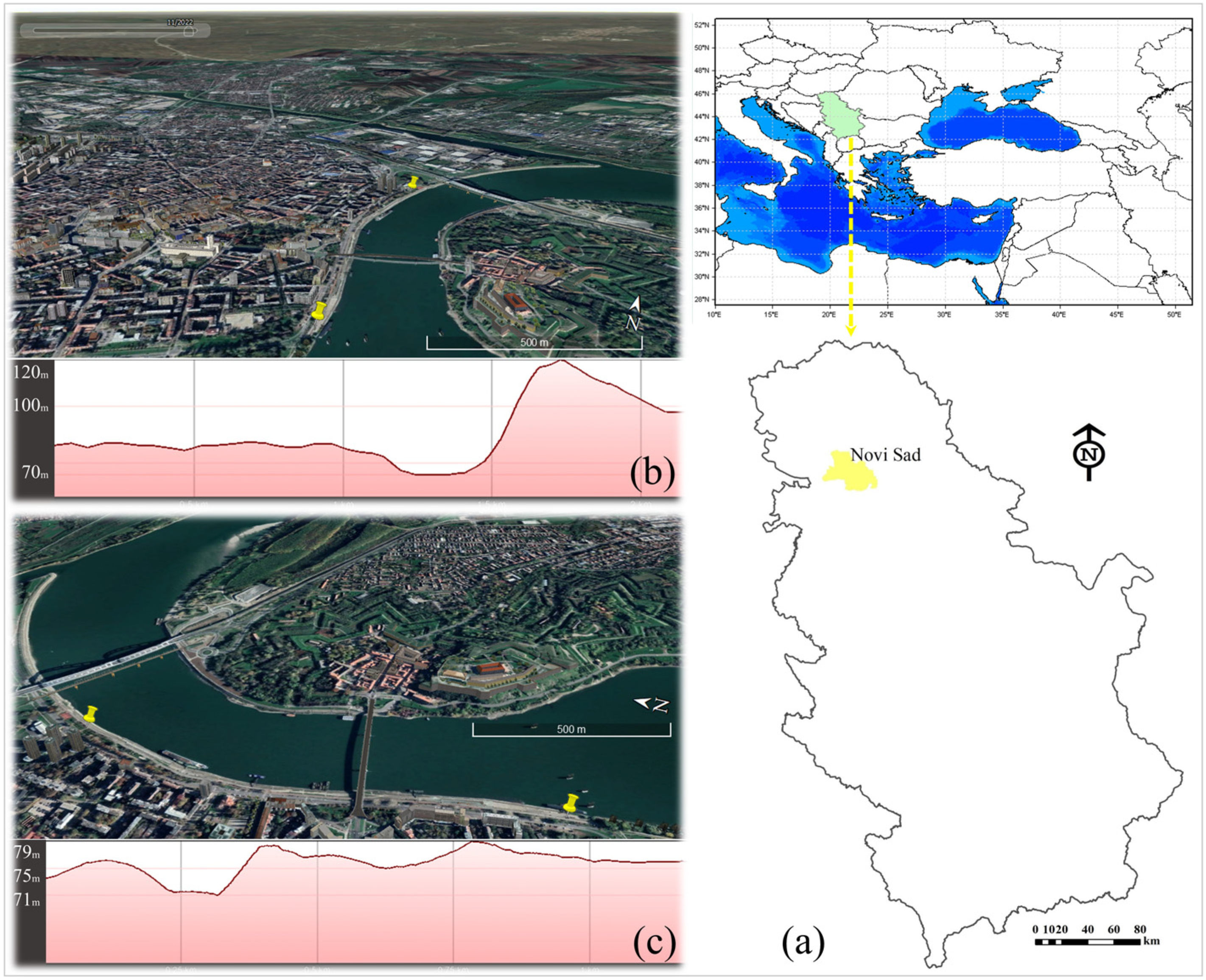

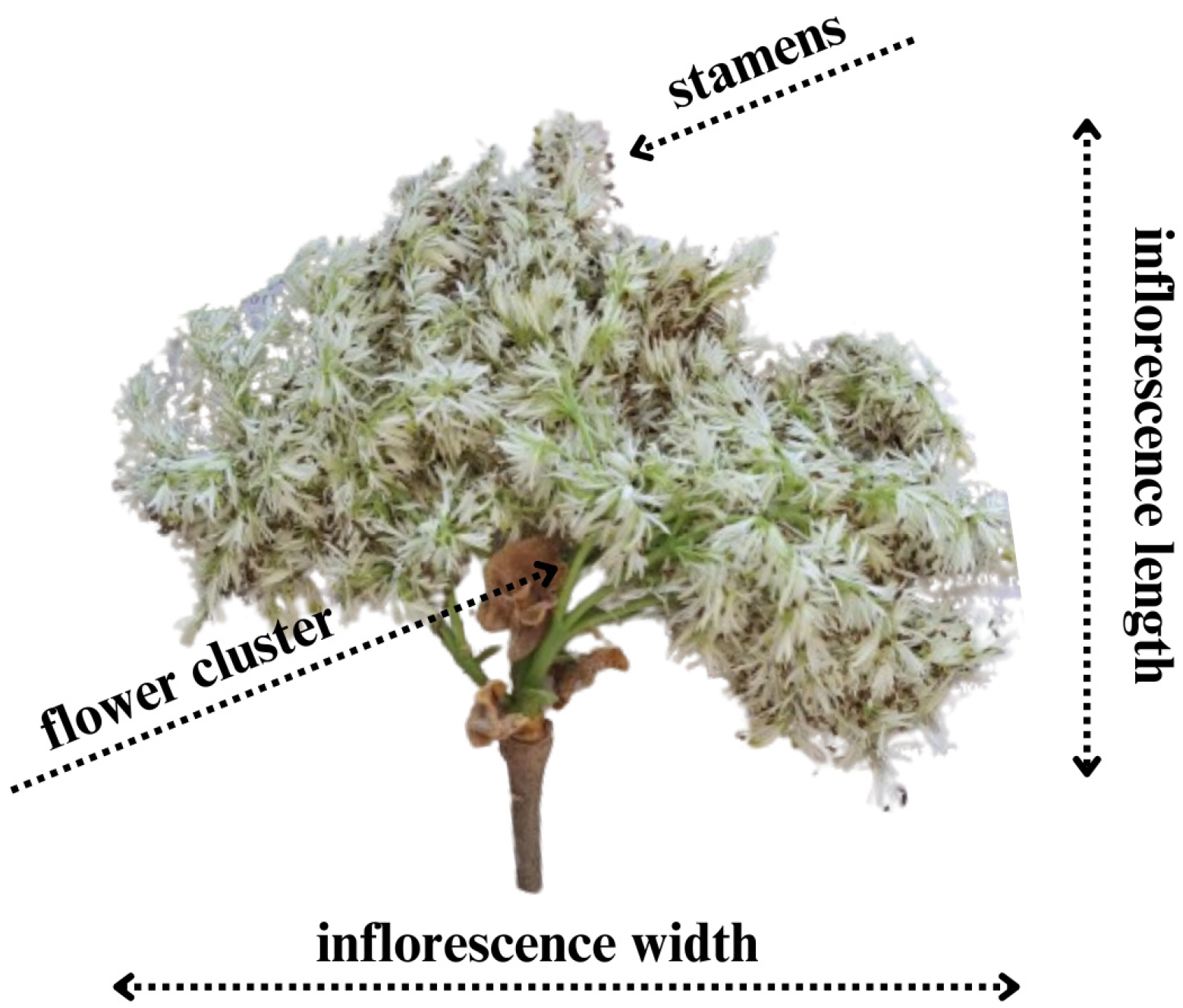
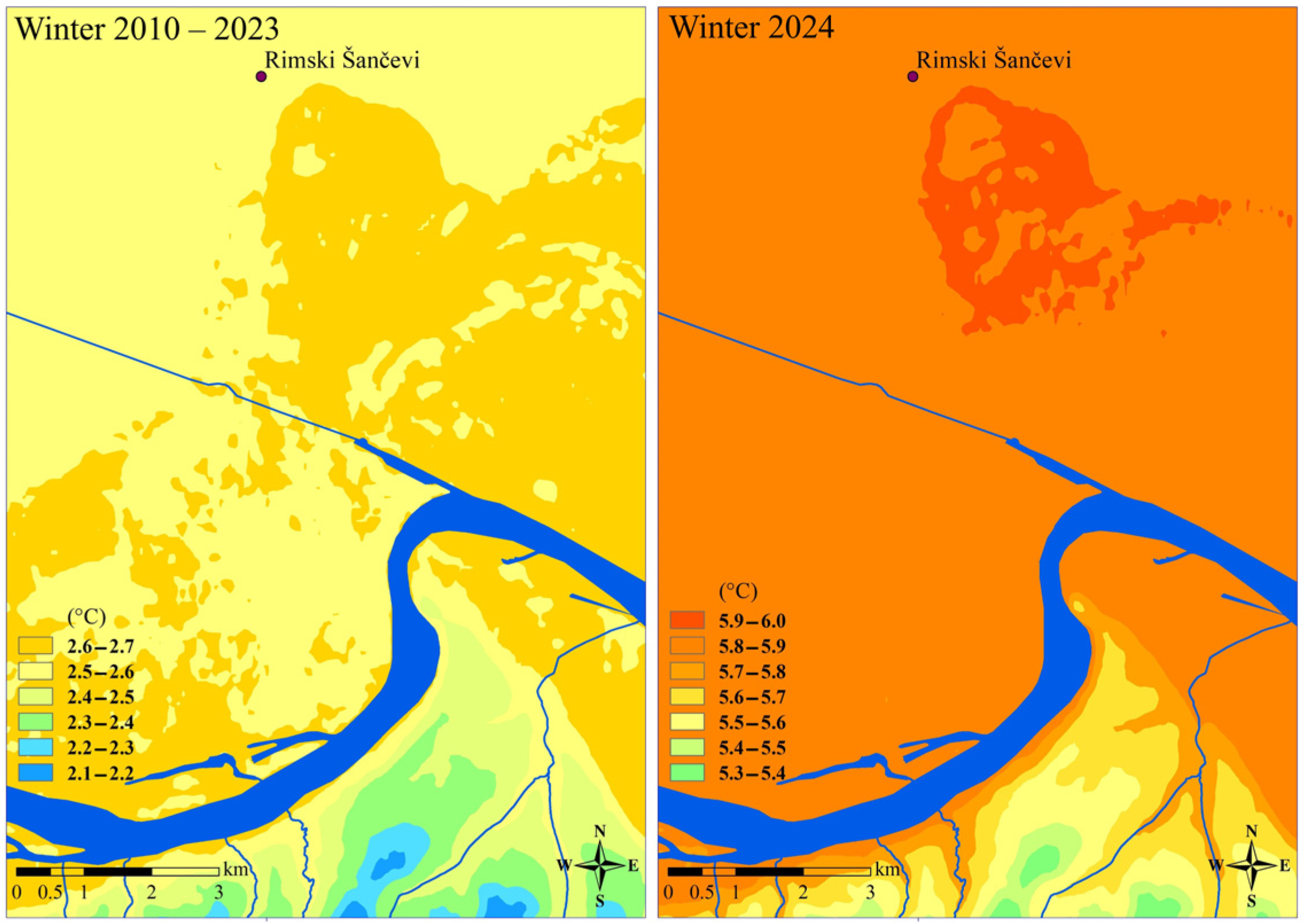


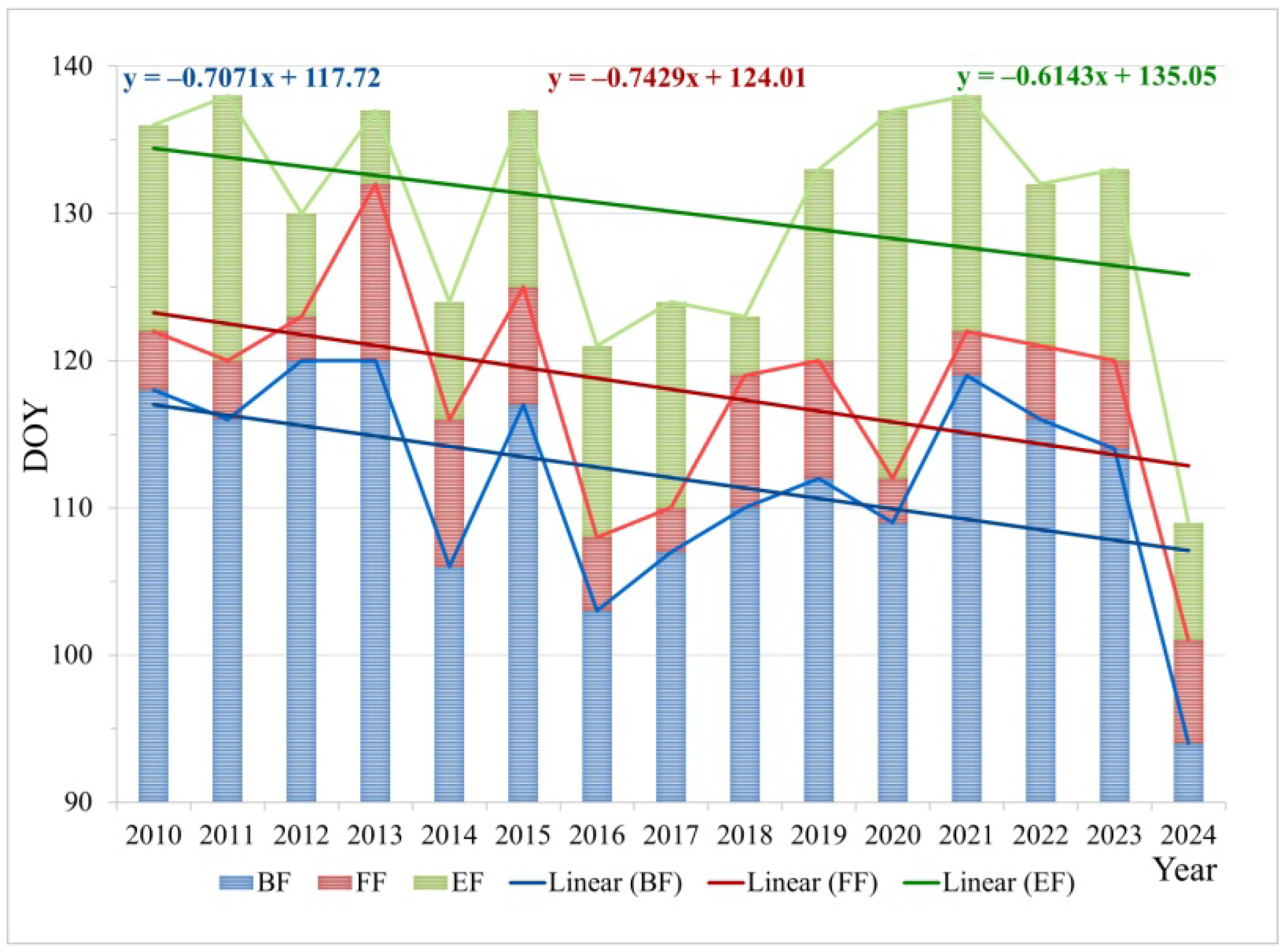
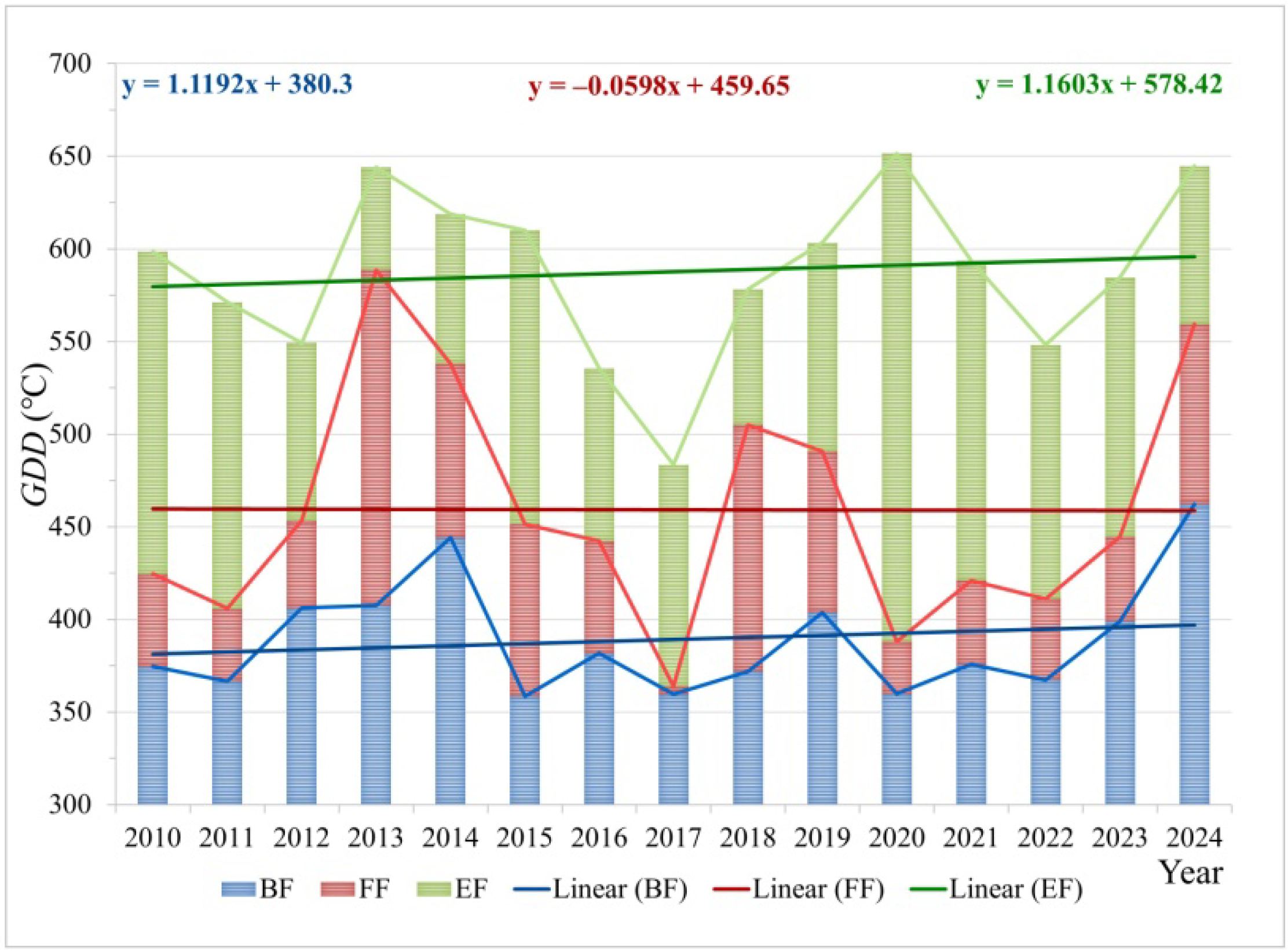
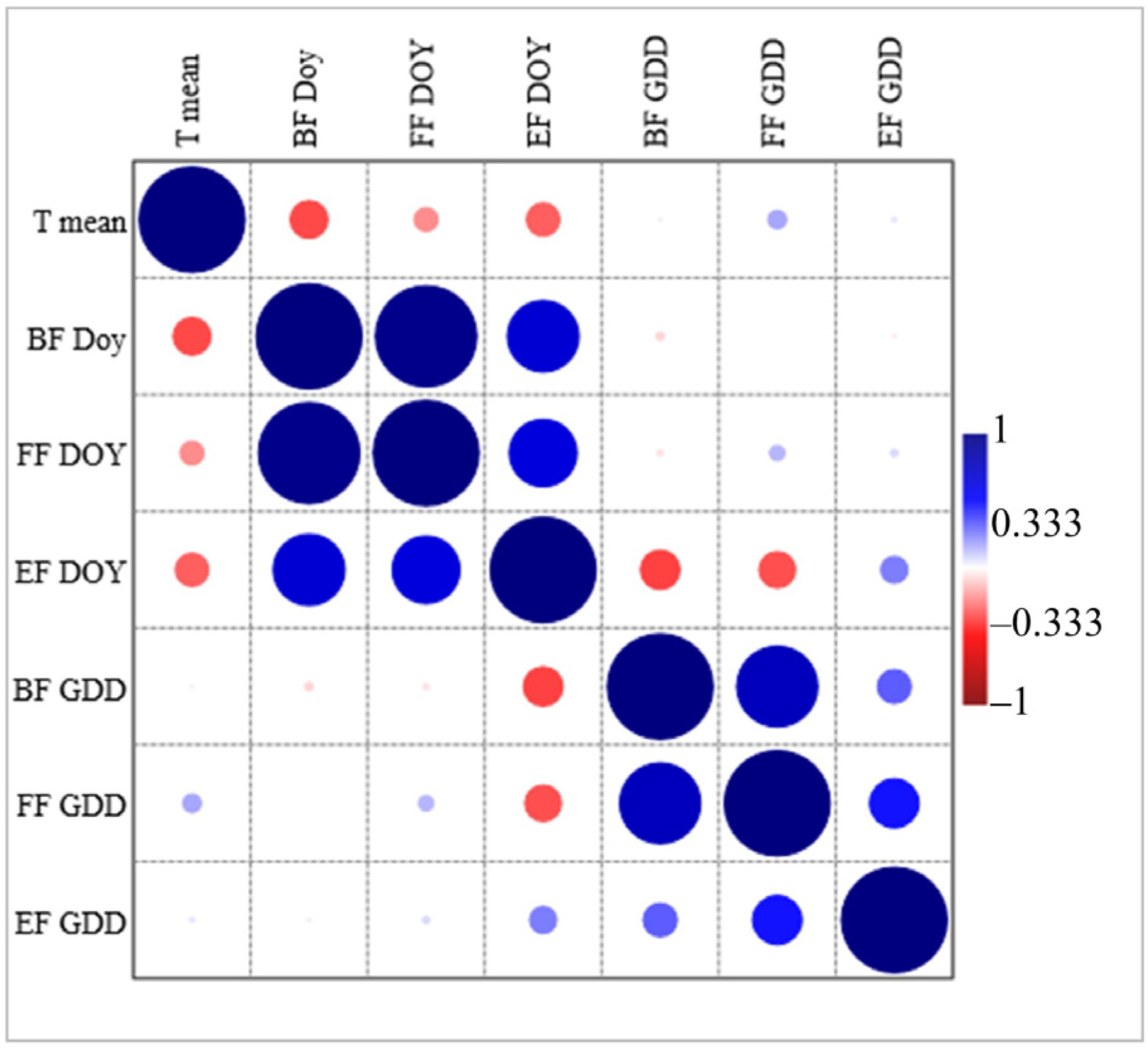
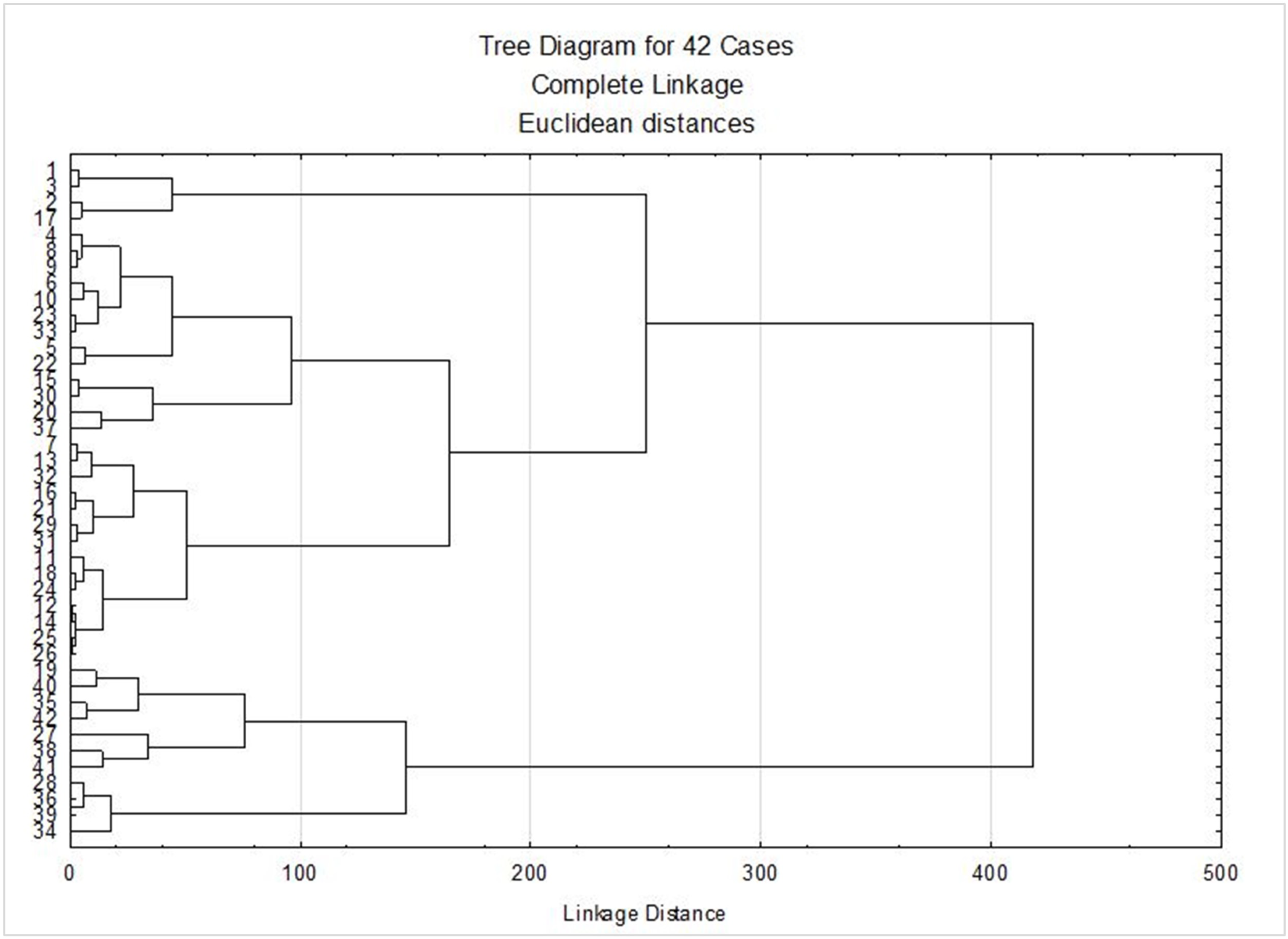
| Tmean (°C) | Perc. Cat. * | Tmean (°C) 1991–2020 | Deviation (°C) | 1991–2020 | 1991–2020 | 1991–2020 | Terciles ** |
|---|---|---|---|---|---|---|---|
| 1991–2020 | 33.-Perc. | 50.-Perc. | 66.-Perc. | Cat. | |||
| February | |||||||
| 9.7 | EW | 2.3 | 7.4 | 1.9 | 2.9 | 4.1 | 1 |
| March | |||||||
| 11.5 | EW | 7.0 | 4.5 | 5.9 | 6.8 | 7.9 | 1 |
| April | |||||||
| 15.3 | VW | 12.4 | 2.9 | 11.8 | 12.6 | 13.1 | 1 |
| May | |||||||
| 18.9 | W | 17.3 | 1.6 | 16.9 | 17.3 | 17.8 | 1 |
| Sum (mm) | Perc. Cat. * | Sum (mm) 1991–2020 | Deviation from the Average (mm) | 1991–2020 | 1991–2020 | 1991–2020 | Terciles ** |
|---|---|---|---|---|---|---|---|
| 1991–2020 | 33.-Perc. | 50.-Perc. | 66.-Perc. | Cat. | |||
| February | |||||||
| 9.1 | D | 36.4 | −27.3 | 26.7 | 39.2 | 46.8 | −1 |
| March | |||||||
| 15.0 | D | 38.7 | −23.7 | 30.3 | 36.7 | 47.8 | −1 |
| April | |||||||
| 21.5 | D | 46.6 | −25.1 | 30.3 | 43.2 | 54.0 | −1 |
| May | |||||||
| 78.0 | N | 78.2 | −0.2 | 59.4 | 74.0 | 84.8 | 0 |
| Climat. Parameter | Tmean | ∑ Precipitation | ||||||
|---|---|---|---|---|---|---|---|---|
| Month Stat. Parameter | II | III | IV | V | II | III | IV | V |
| S * | 45 | 17 | −13 | 9 | −21 | −25 | −7 | −21 |
| Z | 2.18 | 0.79 | −0.59 | 0.39 | −0.99 | −1.18 | −0.30 | −0.99 |
| p | 0.002 | 0.427 | 0.551 | 0.692 | 0.322 | 0.235 | 0.766 | 0.322 |
| Tmean (°C) (year) | BF DOY | FF DOY | EF DOY | BF GDD | FF GDD | EF GDD | |
|---|---|---|---|---|---|---|---|
| N | 14 | 15 | 15 | 15 | 15 | 15 | 15 |
| Min | 11.5 | 94 | 101 | 109 | 358.6 | 363.9 | 483.5 |
| Max | 13.9 | 120 | 132 | 138 | 462.2 | 588.6 | 651.6 |
| Sum | 177.8 | 1681 | 1771 | 1952 | 5838.9 | 6887.5 | 8815.7 |
| Mean | 12.7 | 112.0667 | 118.0667 | 130.1333 | 389.26 | 459.1667 | 587.7133 |
| Std. error | 0.177281 | 1.893514 | 1.972349 | 2.155539 | 8.077888 | 16.70837 | 11.82174 |
| Variance | 0.44 | 53.78095 | 58.35238 | 69.69524 | 978.784 | 4187.545 | 2096.303 |
| Stand. dev | 0.663325 | 7.33355 | 7.638873 | 8.348367 | 31.28552 | 64.71125 | 45.7854 |
| Median | 12.7 | 114 | 120 | 133 | 375.7 | 444.5 | 593.7 |
| 25 prcntil | 12.275 | 107 | 112 | 124 | 366.7 | 411 | 549.3 |
| 75 prcntil | 13.25 | 118 | 122 | 137 | 406.1 | 505 | 618.8 |
| Kurtosis | −0.18121 | 1.09291 | 0.810437 | 1.377669 | 0.903862 | −0.32039 | 0.446129 |
| Coeff. var | 5.223031 | 6.543917 | 6.469966 | 6.415241 | 8.037179 | 14.09319 | 7.79043 |
| Genotypes | IL * | IW | NFC | NS |
|---|---|---|---|---|
| 1. | 9.06 g–m ** | 12.52 k–n | 6.60 k | 628.1 r |
| 2. | 9.38 i–n | 10.69 g–n | 6.60 g–j | 583.6 pr |
| 3. | 9.63 k–n | 11.00 ij | 6.60 f–i | 624.4 r |
| 4. | 8.70 g–k | 10.13 f–n | 6.60 a–g | 498.3 mno |
| 5. | 9.43 j–n | 11.39 j | 4.90 e–i | 537.2 op |
| 6. | 8.78 g–l | 8.80 a–f | 4.00 bcd | 507.8 mno |
| 7. | 7.07 abc | 7.70 abc | 3.80 abc | 403.3 g–k |
| 8. | 9.98 mn | 9.63 d–l | 4.40 b–i | 500.2 mno |
| 9. | 8.23 efg | 10.21 f–l | 4.60 c–i | 502.7 mno |
| 10. | 8.66 g–j | 10.34 f–j | 4.10 a–e | 513.6 no |
| 11. | 8.53 g–j | 9.12 a–l | 3.70 ab | 428.5 i–l |
| 12. | 9.19 h–n | 10.29 f–j | 4.60 c–i | 415.5 h–k |
| 13. | 6.21 a | 9.27 b–h | 4.50 b–i | 405.5 g–k |
| 14. | 8.46 ghi | 9.48 d–m | 4.60 c–i | 416.2 h–k |
| 15. | 10.04 n | 11.73 n | 5.30 ij | 482 l–o |
| 16. | 7.36 cde | 8.77 a–m | 4.30 a–g | 385.4 e–j |
| 17. | 9.65 lmn | 12.20 n | 5.80 j | 588.2 pr |
| 18. | 8.31 fgh | 9.03 a–g | 4.70 d–i | 424.8 i–l |
| 19. | 6.59 abc | 7.63 ab | 4.00 a–d | 326.1 cde |
| 20. | 8.13 d–g | 9.56 d–i | 5.00 f–i | 446.4 j–m |
| 21. | 6.20 a | 8.10 a–d | 4.30 a–g | 387.3 e–j |
| 22. | 6.94 abc | 10.04 f–m | 5.20 hij | 542.8 op |
| 23. | 7.28 bcd | 10.77 h–m | 5.20 hij | 520 no |
| 24. | 8.70 g–k | 11.00 ij | 4.70 d–i | 423 i–l |
| 25. | 7.50 c–f | 9.78 d–j | 4.60 c–i | 414 g–k |
| 26. | 7.45 c–f | 9.10 a–h | 4.60 c–i | 414 g–k |
| 27. | 7.33 b–e | 8.84 a–f | 4.00 a–d | 280 bc |
| 28. | 8.43 gh | 9.76 d–m | 3.80 abc | 228 ab |
| 29. | 7.10 bc | 10.73 hij | 3.80 abc | 380 e–i |
| 30. | 7.50 c–f | 9.73 d–i | 4.80 d–i | 480 l–o |
| 31. | 9.43 j–n | 9.53 d–i | 4.20 a–f | 378 e–i |
| 32. | 7.40 cde | 8.88 a–f | 4.40 b–i | 396 f–k |
| 33. | 8.57 g–j | 8.95 a–f | 5.20 hij | 520 no |
| 34. | 8.75 g–l | 8.91 a–f | 3.50 a | 210 a |
| 35. | 9.75 mn | 10.03 f–j | 5.00 f–i | 350 d–g |
| 36. | 9.47 j–n | 9.80 e–j | 3.70 ab | 222 a |
| 37. | 9.40 i–n | 8.99 a–f | 4.60 c–i | 460 k–n |
| 38. | 6.45 ab | 7.54 a | 4.20 a–f | 314 cd |
| 39. | 9.18 h–n | 9.32 c–m | 3.70 ab | 222 ab |
| 40. | 9.96 mn | 11.75 n | 4.80 d–h | 336 c–f |
| 41. | 6.60 abc | 8.25 a–e | 4.30 a–g | 300 cd |
| 42. | 6.76 abc | 8.24 a–e | 4.50 b–h | 356 d–h |
Disclaimer/Publisher’s Note: The statements, opinions and data contained in all publications are solely those of the individual author(s) and contributor(s) and not of MDPI and/or the editor(s). MDPI and/or the editor(s) disclaim responsibility for any injury to people or property resulting from any ideas, methods, instructions or products referred to in the content. |
© 2024 by the authors. Licensee MDPI, Basel, Switzerland. This article is an open access article distributed under the terms and conditions of the Creative Commons Attribution (CC BY) license (https://creativecommons.org/licenses/by/4.0/).
Share and Cite
Čukanović, J.; Ljubojević, M.; Djordjević, S.; Narandžić, T.; Petrov, D.; Ocokoljić, M. The Impact of Climate Variability on the Blooming of Fraxinus ornus ‘Globosa’ as a Component of Novi Sad’s (Serbia) Green Infrastructure. Sustainability 2024, 16, 8404. https://doi.org/10.3390/su16198404
Čukanović J, Ljubojević M, Djordjević S, Narandžić T, Petrov D, Ocokoljić M. The Impact of Climate Variability on the Blooming of Fraxinus ornus ‘Globosa’ as a Component of Novi Sad’s (Serbia) Green Infrastructure. Sustainability. 2024; 16(19):8404. https://doi.org/10.3390/su16198404
Chicago/Turabian StyleČukanović, Jelena, Mirjana Ljubojević, Sara Djordjević, Tijana Narandžić, Djurdja Petrov, and Mirjana Ocokoljić. 2024. "The Impact of Climate Variability on the Blooming of Fraxinus ornus ‘Globosa’ as a Component of Novi Sad’s (Serbia) Green Infrastructure" Sustainability 16, no. 19: 8404. https://doi.org/10.3390/su16198404










